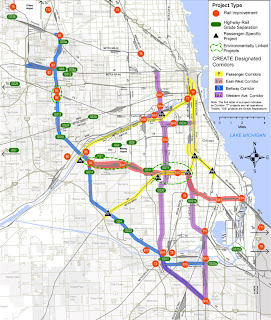Want to transport your goods the slowest way possible? Try sending them via train through Chicago, where for more than a decade trains have gone so slow that they average speeds of less than 5 miles per hour. Because of the bottleneck that the transportation of goods has experienced in the Chicago – the nation’s largest commercial train transit pass through – Federal, State, local and industry offices are working on a plan to create a more efficient rail system in Chicago. The hope is that when the project is completed, the speed at which trains travel through the Chicago area will significantly increase, and the backup of cargo trains waiting outside Chicago to make it to the other side will significantly decrease.
- Improve passenger rail service
- Reduce freight rail congestion to boost regional and national economic competitiveness
- Reduce motorist delay due to rail conflict at grade crossings
- Enhance public safety
- Promote economic development
- Create and retain jobs
- Improve air quality
- Reduce noise from idling or slow-moving trains


